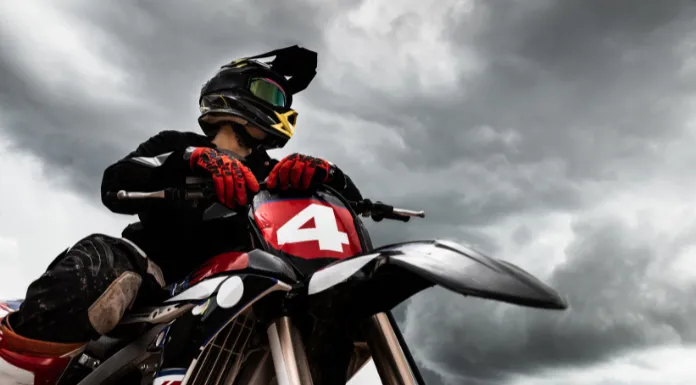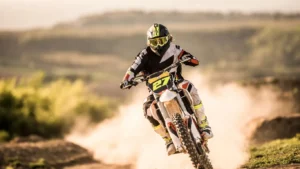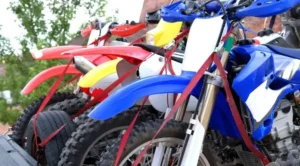Dirt bike riding is thrilling, and dirt bike enthusiasts will find it challenging to stop utilizing their bikes throughout various seasons. Thankfully, you can turn riding a dirt bike into a four-season activity with the proper preparation.
Riding a dirt bike is enjoyable; some even refer to it as a weather break. Event planners have created weather tracks to account for this ardor for exciting rides. To help you, we have put together this guide on the basics of dirt bike riding for different seasons.
A dirt biker must also adjust their bike to be more weather-resistant.
These circumstances also affect how well a specific bike will perform. Therefore, it is advisable to make revisions to account for all potential scenarios. Come along as we highlight this below.
Can you ride a dirt bike in winter?
Yes. If you live in a Chilly region, you can still enjoy your dirt bike in the winter. There is no justification for putting your bike away.
Yes, it’s difficult, and you’ll need to spend money on equipment and modifications, but we’ll let you in on a few insider tips. If you are ready in advance, riding a dirt bike in Chilly and snowy weather is possible.
It entails dressing in layers and modifying your dirt bike to prepare you for the cooler weather. Most dirt bike cylinders will still function until they are below freezing.
Tips for Winter Dirt Bike Riding
Without a doubt, the dangers are worth the trials. During the off-season for other riders, you’ll find the trails and courses to be calmer, and you’ll be honing your abilities.
With our tips, you truly have no reason not to ride your dirt bike during the winter. They consist of:
1. Invest in some riding attire for the winter.
To begin with, purchase a quality jacket and riding attire. Under each, you may want to wear thermals to reduce the effects of the wind chill significantly.
Additionally, get some ADV riding gloves for chilly weather instead of your standard MX gloves.
2. Recognize that chilly dirt bike tires provide less traction.
You will need to warm up your tires before each ride, just as you would on a street cruiser or a racing motorcycle.
It will significantly improve the grip. If you can see, find a quiet bitumen road to wobble it side to side to pre-heat your tires.
3. Attach hand protectors.
Dirt bike handguards, if you have not previously installed a pair, prevent a significant amount of wind from freezing your knuckles and weakening your grip.
You may get complete wrap-around handlebar protection or broad square-style protectors.
4. Look out for sunburned skin
Riding a dirt bike in the winter may cause windburn, particularly on your hands and face. Remember this and attempt to layer up whenever you can.
It results from the continuous skin rubbing against the wind, which, among other things, results in extreme dryness.
5. Put on a heated riding jacket during the winter
Do you know that 12-volt heated winter coats are available? These are some of the finest financial investment generals.
They are often used by adventure riders while covering long distances during the winter months, and they are undoubtedly beneficial to keep you riding for a long time out on the trails.
The main drawbacks are that they are heavy and you will need to add a 12V outlet.
6. Purchase some winter dirt bike tires
Not all dirt bike tires are made equal; some provide more channels and traction for winter riding, but these same tires can deteriorate more quickly in the summer.
Think about owning two sets of tires—one for the winter and one for the summer. We may suggest studded tires for riding in the snow, which are readily available online for most dirt bike brands and models.
7. Pay attention to any internal perspiration
It is possible to unintentionally go overboard while layering up to be warm when riding a dirt bike.
If you begin to sweat a little while wearing garments, the moisture that results from this might cause you to become more relaxed and less able to hold heat. Remove layers as necessary.
8. Think about getting new goggles or a helmet
You should consider buying a specific helmet with less front-end breathability for winter riding, just as you would have different riding tires for colder months.
It would be pretty beneficial to have a pair of goggles that fit well and reduce air intake. Some riders wear a neck shield in addition to their jersey, jacket, and helmet.
Is spring a good dirt bike riding season?
Yes. The dirt bike riding season starts each year in early spring for those who live in northern latitudes.
That means it’s time to haul your dirt bike out of storage for the winter, roll up your sleeves, and start getting ready for the riding season.
Discover when the dirt bike trails in your region open and if your state needs OHV registration at the same time as prepping your dirt bike for the riding season.
Things to do before dirt bike riding in spring
Winter doesn’t linger forever, despite what some dirt bike riders may believe.
The first day of riding season appears out of nowhere when you’re tired of the chilly weather and snow.
The official start of spring is March 20. But seasoned dirt bike riders know that weather conditions are more important than the date on the calendar in determining the first suitable riding day.
Here are some preparations you may make for spring and the start of the new dirt bike riding season:
1. Organizing
As with any successful undertaking, preparing to ride on the first lovely day requires thorough preparation.
It’s more complicated than removing the cover, inserting the key, and leaving. Getting ready to ride a dirt bike is the first step in planning.
The following three crucial aspects need evaluation:
- The state of your dirt bike
- Your knowledge and riding abilities
- Your riding equipment
You may proceed with getting everything up to speed in terms of preparation once you know where things stand for you and your bike.
2. Planning
It’s amazing how many riders don’t prepare ahead, only to find themselves unprepared when the first pleasant day comes.
Dirt bike shops see a surge in service requests and have a busy schedule with many appointments for weeks.
Furthermore, the school will soon reserve dates for rider education courses until the middle of the summer.
Planning will benefit you. You should schedule a spring tune-up or maintenance and reserve a spot in a rider safety course. Now that you have booked an appointment, it would be wise to go through everything again.
3. Examining
Most of us have a solid notion of our bike’s mechanical condition before we put it away for the winter. But everything changes with time.
Perform a comprehensive check of your dirt bike. Call the shop and inform them if anything appears to need further maintenance.
T-CLOCS is a phrase that dirt bike riders are familiar with when referring to inspection. Know it, cherish it, and commit it to memory. It is true since it covers servicing your bike all year long, not just in the spring. It stands for:
- Tires
- Controls
- Lighting
- Oil
- Chassis
- Stands
The Dirt Bike Safety Foundation advises a T-CLOCS examination before every ride, but it is essential after a bike has spent a long winter hibernating.
While this examination can take some time, safety should always come first. If you don’t feel confident doing these chores, ask the service center to handle them at the next visit.
They are used to the process and will probably return it to you right away.
4. Updating your knowledge
Even seasoned riders will need to brush up on their riding techniques after a few months off the bike. Allow yourself time to become familiar with your bike.
It is a compelling argument in favor of attending a rider training course at least once every two years.
Whether you plan to enroll in a class this year or not, it is crucial to regularly practice your fundamental riding techniques, particularly at the start of a new riding period.
Here are several abilities to hone:
- Braking
- Skidding
- Counter-steering and sliding
- Avoidance of obstacles
- Checking for dangers
Once it’s been a winter of freezing and thawing, the road conditions might be pretty bad, depending on how soon you start driving after the snow.
The majority of spring is spent by road personnel filling potholes and cracks in the pavement, which are significant dirt bike dangers.
Ride carefully, monitor your speed, and wear protective gear if anything unpleasant happens.
Conclusion
In conclusion, riding a dirt bike is a fantastic modern pastime. Don’t allow the changing weather to stop you from riding your dirt bike. If you enter the fight prepared, you will have a lot of fun.
You may also work on your talents and have far more fun while everyone else is at home lounging on the sofa. There won’t be any large crowds or oppressive summer heat this time.






